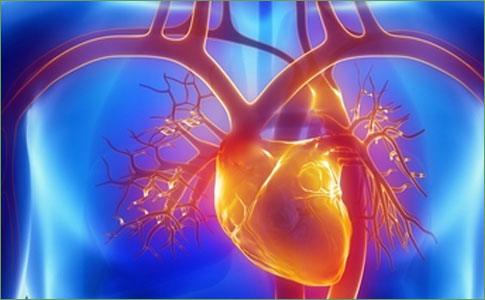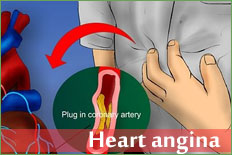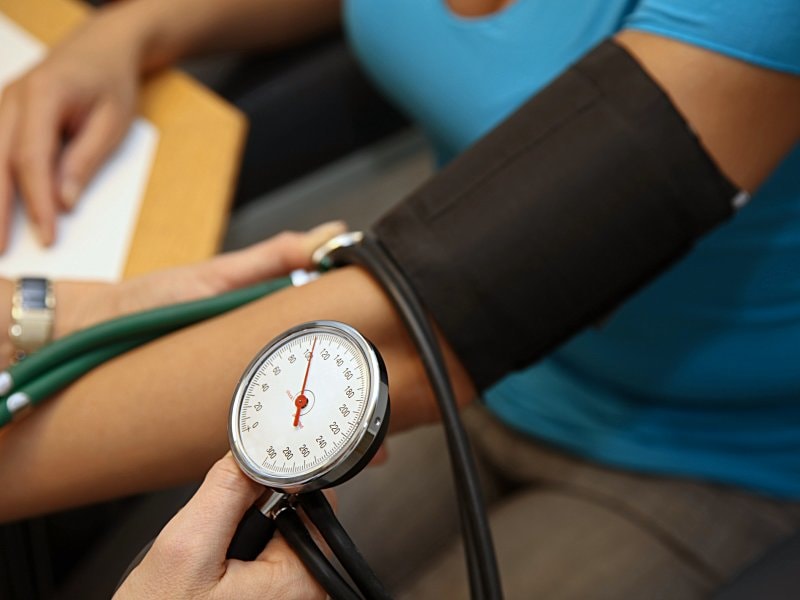Health Centers > Hypertension Health Center > Treatment of Hypertension - Moderate or severe hypertension in children
Treatment of Hypertension
Introduction
If the cause cannot be removed, or while awaiting definitive treatment, it may be necessary to lower the blood pressure. The aims of treatment are to lower blood pressure and reverse organ damage without inducing significant side effects. If there is renal disease, then renal function can deteriorate as pressures are lowered.
EMERGENCY TREATMENT
Hypertensive emergencies are those with very high blood pressures or with any of the features discussed earlier. If the blood pressure needs to be lowered rapidly, then the agents listed in Table 22-30 should be considered.
LONG-TERM THERAPY
Because therapy for chronic hypertension may need to go on for years, even for life, it is essential to be sure that therapy is needed and then to commence with simpler forms before using more powerful and more complex drug treatment. It may be prudent to obtain 24-hour blood pressure measurements, which often show that the highest pressure is that in the doctor's office ("white coat hypertension"). Attempts to restore that atypical pressure to normal may lead to unacceptable hypotension.
Reduction of weight is important because obesity is an independent cause of left ventricular hypertrophy. Regular exercise should be encouraged. The patient should avoid smoking and a diet high in saturated animal fats because these factors add to the risk of later atherosclerosis. The diet should be high in potassium, which may help to lower pressures. Salt should be restricted, but because not all hypertensives are salt sensitive, the restriction can be relaxed if it is found not to lower pressure. Recent studies suggest that the chloride in salt causes the pressure elevation.
Psychotherapy to help the patient deal with stresses may be of value.
Sedative drugs such as barbiturates or benzodiazepines (Valium) can be very helpful, provided that they are used with precautions about excessive sedation and the risk of addiction.
PRINCIPLES OF DRUG THERAPY
Hypotensive drugs may work at one or more levels in the body to lower cardiac output or cause systemic arterial vasodilatation (Table 22-31).
Often the primary action is partly or completely counteracted by compensatory changes. For example, vasodilatation may cause a rise in heart rate and cardiac output that returns pressure to its former level, and this may also happen if a fall in cardiac output causes reflex vasoconstriction.
Furthermore, reducing blood volume with a diuretic usually increases renin secretion. On the other hand, lowering blood pressure may increase renin production and lead to sodium retention and an increase in blood volume, thus restoring blood pressure to its former level. Therefore, if blood pressure is not effectively lowered by moderate doses of a drug, it is best to add another drug with a different mode of action. Not only does this lower blood pressure more effectively, but unwanted side effects are minimized by keeping the dose of each drug relatively low. When treating for the long term, it is important to start on low doses of drugs and increase the dose only after 3 to 7 days.
This reduces the chances of incurring severe hypotension or severe side effects. Pressures should be measured with the patient supine and erect to detect excessive postural hypotension. If hypertension has been chronic, do not attempt to lower blood pressure to normal too rapidly. Hypertension thickens arteriolar walls, so that the minimal vascular resistance is higher than normal. Under these circumstances the only way to reduce blood pressure to normal is to decrease cardiac output below normal. It is better to reduce blood pressure moderately at first, wait some weeks until the vessels are presumably less thick, and then attempt to return blood pressures to normal in stages.
Not all agents that lower blood pressure reverse left ventricular hypertrophy. Those that do include adrenergic blocking agents, calcium blockers, and angiotensin-converting enzyme inhibitors, whereas diuretics and smooth muscle vasodilators on their own are less effective, probably because they do not interfere with sympathetic reflexes and so lead to tachycardia and increase of cardiac output. Therefore, sometimes with severe hypertension one or more of the first group of agents are used first, but a diuretic is added if there is fluid retention, or a smooth muscle vasodilator is added if pressures need to be lowered more. Furthermore, although β-adrenergic blockers have been used successfully for many years, they often produce unacceptable lethargy, weakness, and tiredness; therefore, they are less favored for monotherapy than they were.
SPECIFIC FEATURES OF DRUGS USED IN AMBULATORY TREATMENT
The doses in common use are listed in Table 22-32. Many of these doses are based on adult doses corrected for weight because there have not been enough careful studies of all of these agents in children; consequently, different authorities recommend different doses of some of these drugs.
Angiotensin-converting enzyme inhibitors decrease angiotensin concentrations and so reduce vasoconstriction and aldosterone concentrations and cause increased excretion of salt and water despite the increase in plasma renin. They also increase bradykinin concentrations, which may cause coughing. To avoid severe hypotension, these drugs should be started in low dosage, particularly if the patient is dehydrated. Angiotensin receptor blockers block AT-1 receptors and do not affect bradykinin, and so may avoid the irritating cough. All these agents can rarely cause angioneurotic edema and renal failure.
Calcium blockers can now be given once or twice daily with slow release (SR) preparations. Nifedipine and amlodipine are among the most popular and effective drugs for children with hypertension and renal disease. Side effects of reflex tachycardia and headache occasionally limit their use.
No β-adrenergic receptor blocker is markedly superior to the others in lowering blood pressure, but they differ in side effects and frequency of dosage. These agents decrease renin secretion but may cause salt and water retention, so that diuretics may be needed as well. Decreased sympathetic β-adrenergic receptor stimulation of the airways and intestines leaves unopposed vagal action, which can cause bronchospasm and, rarely, diarrhea; cardioselective agents such as metoprolol or atenolol are less likely to cause bronchospasm than is propranolol. Because these drugs cross the blood-brain barrier, they may cause changes of mood or behavior.
α-Adrenergic receptor blockers such as prazosin act on presynaptic α-adrenergic receptors. Prazosin differs from the others in this group in not causing significant hypotension with exercise and not causing much postural hypotension and tachycardia. This is believed to result from blockade of the reuptake of norepinephrine by presynaptic nerve endings. Prazosin may cause profound postural hypotension after the first dose; thus, patients should take the first dose at night and be warned not to stand up suddenly. Other α-adrenergic blockers have limited usefulness. Phentolamine is used to test for increased circulating catecholamines as the cause of the hypertension, and phenoxybenzamine, given once daily and so better for long-term administration, is used to prepare patients with pheochromocytomas for surgery. Its dose can be increased at 7- to 14-day intervals. These agents, too, are used in treating the rebound hypertension caused by α-methyldopa or clonidine withdrawal.
CNS sympathetic inhibitors such as α-methyldopa and clonidine act predominantly in the central nervous system to reduce sympathetic outflow. In addition, α-methyldopa replaces norepinephrine in the storage granules of the vesicles and acts as an inefficient neurotransmitter. If the drugs are stopped suddenly, there may be sympathetic overactivity and severe rebound hypertension, which may limit their use in unreliable patients. A transdermal patch that releases clonidine at a fixed rate and is changed every 7 days has been used effectively in children, especially in those who dislike taking pills. The patch may cause contact dermatitis.
Peripheral adrenergic blocking agents such as reserpine and guanethidine affect the formation, storage, and release of norepinephrine in the storage granules of the postganglionic sympathetic nerve endings. They are used little today because of unacceptable side effects.
Diuretics reduce salt and water retention and so reduce blood volume but may also have some direct vasodilator effect. They may be all that is needed in mild hypertension. They are given once daily each morning. Doses (Table 22-32) are lower than those used in treating congestive heart failure. Doses can be increased after 1 to 2 weeks if there is an inadequate therapeutic effect. Thiazides are most often used, but better diuresis, if needed, may be obtained with oral furosemide. The hypotensive effects of these diuretics can be overcome if salt intake is high, and people tend to increase their salt intake when they take these diuretics. Therefore, patients should avoid salty foods and not add salt when food is brought to the table. A salt substitute may be helpful. Salt restriction is particularly important in renal hypertension, in which sodium excretion is often markedly impaired and in which an increased blood volume is often a major factor in the hypertension. Thiazides may increase blood glucose and lipoprotein concentrations.
Direct arteriolar vasodilators such as hydralazine usually increase renal blood flow and do not alter glomerular filtration rate. By lowering blood pressure, however, they may increase renin secretion as well as salt and water retention, so that they should be combined with diuretics. At high dosages, hydralazine causes a syndrome that resembles systemic lupus erythematosus and is reversible on withholding the drug. Minoxidil is a powerful vasodilator that is used in hypertension refractory to other forms of therapy.
REFERENCES
AVAR MY , HOGG, RJ , ARANT BS JR , Seikaly MG: Etiology of sustained hypertension in children in the southwestern United States. Pediatr Nephrol 8:186, 1994
BALFE JW , LEVIN L , TSURU N , et al: Hypertension in childhood. Adv Pediatr 36:201, 1989
BAO W , THREEFOOT SA , SRINIVASAN SR , BERENSON GS: Essential hypertension predicted by tracking of elevated blood pressure from childhood to adult hood: the Bogalusa Heart Study. Am J Hypertens 8:657, 1995
CAULFIELD M , LAVENDER P , FARRALL M , et al: Linkage of the angiotensinogen gene to essential hypertension. N Engl J Med 330:1629, 1994
DEAL JE , SNELL ME , BARRATT TM , DILLON MJ: Renovascular disease in childhood. J Pediatr 25:55, 1992
HEDIGER ML , SCHALL JI , KATZ SH , et al: Resting blood pressure and pulse rate distributions in black adolescents. The Philadelphia blood pressure project. Pediatrics 74:1016, 1984
HILTON PJ: Cellular sodium transport in essential hypertension. N Engl J Med 221, 1986
HORAN MJ , LENFANT C: Epidemiology of blood pressure and predictors of hypertension. Hypertension 15(Suppl I):1, 1990
INGELFINGER JR: Pediatric Hypertension. Philadelphia, WB Saunders, 1982
JORGENSEN RS , HOUSTON BK: Family history of hypertension, personality patterns, and cardiovascular reactivity to stress. Psychosom Med 48:102, 1986
KAAS IK: Blood pressure in offspring of hypertensive parents. Acta Paediatr Scand 73:842, 1984
KURTZ TW , AL-BANDER HA , MORRIS RC JR: "Salt-sensitive" essential hypertension in man. N Engl J Med 317:1043, 1987
LAUER RM , BURNS TL , CLARKE WR: Assessing children's blood pressure: considerations of age and body size. The Muscatine study. Pediatrics 75:1081, 1985
LAUER RM , CLARKE WR , BEAGLEHOLE R: Level, trend, and variability of blood pressure during childhood. The Muscatine study. Circulation 69:242, 1984
LIFTON, RP: Molecular genetics of human blood pressure variation. Science 272:676, 1996
LOGGIE JMH: Hypertension in children and adolescents. I. Causes and diagnostic studies. J Pediatr 74:331, 1966
MAHONEY LT , CLARK WR , BURNS TL , LAUER RM: Childhood predictors of high blood pressure. Am J Hypertens 8:6085, 1991
PICKERING TG , LARAGH JH: Renovascular hypertension. In: BRENNER BM , RECTOR FC , eds: The Kidney. Philadelphia, WB Saunders, 1991
Report of the Second Task Force on Blood Pressure Control in Children - 1987. Pediatrics 79:1, 1987
ROSNER B , COOK NR , EVANS DA , et al: Reproducibility and predictive values of routine blood pressure measurements in children. Am J Epidemiol 126:1115, 1987
SINAIKO AR: Hypertension in children. N Engl J Med 335:1968, 1996
SOKOLOW M , PERLOFF D , COWAN R: Contribution of ambulatory blood pressure to the assessment of patients with mild to moderate elevation of office blood pressure. Cardiovasc Rev Rep 1:295, 1980
STRAUER BE , BAYER F , BRECHT HM , MOTZ W: The influence of sympathetic nervous activity on regression of cardiac hypertrophy. J Hypertens 3(Suppl 4):39, 1985
Update on the 1987 Task Force on High Blood Pressure in Children and Adolescents: A Working Group Report from the National High Blood Pressure Education Program. Pediatrics 98:649, 1996
VOORS AW , WEBBE LS , BERENSON G: Relationship of blood pressure levels to height and weight in children. Cardiovasc Med 3:911, 1978
WEINBERGER MH , MILLER JZ , LUFT FC , et al: Definitions and characteristics of sodium sensitivity and blood pressure resistance. Hypertension 8(Suppl II):127, 1986
WILLIAMS RR , HUNG SC , HASSTEDT SJ , et al: Multigenic human hypertension: evidence for subtypes and hope for haplo-types. J Hypertens 8(Suppl 7):S39, 1990
ZACHARIAH PK , SHEPS SG , ILSTRUP DM , et al: Blood pressure load - a better determinant of hypertension. Mayo Clin Proc 63:1085, 1988
DE QUATTRO V: Treating hypertensive crises: which drugs for which patient? J Crit Illness 2:24, 1987
FREIS ED: Should mild hypertension be treated? N Engl J Med 307:306, 1982
GARCIA JY , VIDT DG: Current management of hypertensive emergencies. Drugs 34:263, 1987
MACMAHON SW , WILCKEN DE , MACDONALD GJ: The effect of weight reduction on left ventricular mass. A randomized controlled trial in young, overweight hypertensive patients. N Engl J Med 314:334, 1986
SINAIKO AR: Treatment of hypertension in children. Pediatr Nephrol 8:603, 1994
WOLLAM GL , HALL WD , PORTER VD , et al: Time course of regression of left ventricular hypertrophy in treated hypertensive patients. Am J Med 75(Suppl):100, 1983
WOOD AJJ: Pharmacologic differences between beta blockers. Am Heart J 108:1070, 1984
KAPLAN NM , DEVERAUX RB , MILLER HS JR: Task Force 4: systemic hypertension. J Am Coll Cardiol 24:885, 1994
MARON BJ , MITCHELL JH: Revised eligibility criteria for competitive athletes with cardiovascular abnormalities. J Am Coll Cardiol 24:848, 1994
NUDEL DB , GOOTMAN N , BRUNSON SC , et al: Exercise performance of hypertensive adolescents. Pediatrics 65:1073, 1980
STRONG WB: Hypertension and sports. Pediatrics 64:693, 1979


